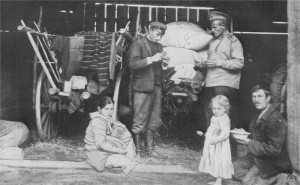Peter Gatrell is a Professor of Economic History at the University of Manchester. He has demonstrated a great interest European cultural history. His publications focus on population displacement and state-building following World War I and World War II. When considering his extensive experience studying European history, it is evident that his projects correlate with his interests.
While reading Gatrell’s work, “Displacing and Re-placing Populations in the Two World Wars: Armenia and Poland Compared,” I was captivated by his comparison between these two ethnic groups’ histories. Although I have been exposed to the histories of World War I and II, I have not had the chance to learn about the many ethnic groups that were left stranded after these wars. Many Armenians chose to live in “Soviet Armenia” following World War I because it was seen as one of the best options for resettlement.[1] Although this was one of their better options, the Soviets worked to “’keep [them] for the Armenian nation’ to develop ‘loyal citizens of Red Armenia.’”[2] Rather than supporting their cultural differences, Armenians were expected to adopt Soviet values following World War I. Although these sentiments were stressed, Armenians established repatriation following World War II during the 1940s. They were focused on maintaining their cultural differences from the Soviet Union while establishing this state. The Armenians’ desires for separation from the Soviets were quite strong due to the homogeneity among the population. (Image of Polish refugees:http://www.firstworldwar.com/photos/refugees.htm)
(Image of Polish refugees:http://www.firstworldwar.com/photos/refugees.htm)
Although the Poles were also refugees following these wars, they went through a different experience than the Armenians. After World War I, Poles were very focused on returning back to Poland. However, after returning home, they discovered that “’home’ looked very different.”[3] This negative viewpoint showcased that their desire to reestablish a strong Poland was less desirable compared to the nationalistic Armenians. Additionally, establishing a stable Poland during the interwar period proved more difficult for Poland because of the tumultuous relations compared between Poles, Ukrainians and Jews.[4] The Armenians and Poles certainly shared the desire to find a country for establishment; however, it appears that the Armenians’ desire was more unified than the Poles.
What are your thoughts on these displacements? What other differences and similarities between these two ethnic groups’ reestablishments do you find interesting?
[1] “Displacing and Re-placing Population in the Two World Wars: Armenia and Poland Compared,” Peter Gatrell, 514.
[2] Ibid.
[3] Ibid, 520.
[4] Ibid, 521.
